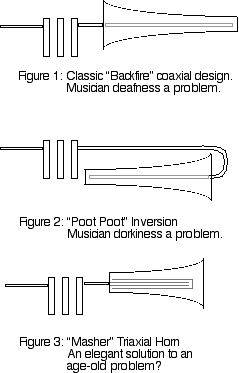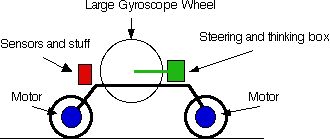Please note: There’s a lot of engineering and physics in here, but give it a try even if you hate that stuff. I’ve tried to give the Carl Sagan version here. I thought about splitting this entry up, but it’s kind of a big-picture thing. I’ll add some drawings tomorrow (er… later this morning). If you start to glaze over, you can always see what’s happening at the Suicide Squirrel Death Cult.
I’ve got it all worked out, see. I had most of the plan worked out some time ago, but I had put it on the back burner. The other day my brother sent me an article mentioning the space launch contest and that got me to thinking again. Now it’s the wee hours of the morning, and the last piece of the puzzle has fallen into place.
Here’s how space flight works now: you make a huge bomb with a nozzle at one end. You set off the bomb and hope it burns in a controlled manner long enough for it to carry something worthwhile into space. Now you have something way up there and when you bring it back down you have to do something to slow it down, or, like a truck rolling out of control down a mountain, something bad is going to happen at the bottom. To get rid of all that potential energy, you use the air to slow you down. That generates an enormous amount of heat, so you hope the payload makes it to the ground without burning up. We have seen tragedy both on launch and landing as our frail machines proved unable to handle those enormous amounts of energy. There are several other drawbacks as well. Off the top of my head:
- Inefficiency: Most of the fuel is used to lift…fuel. I don’t know the ratio of fuel mass to payload mass with modern propellants, but it’s still ridiculous. You’ve seen rockets taking off – they’re huge cylinders of fuel with a tiny capsule on top.
- Cost: even with reusable spacecraft, big parts are thrown away on each launch. That fuel ain’t cheap, either.
- Environment: The exhaust from a rocket has some nasty, nasty chemicals, and nothing gets those chemicals into the upper atmosphere like a rocket. Manufacturing the fuel has some ugly byproducts as well.
It’s time to rethink the whole proposition and take a step backward. Remember Jules Verne? He shot his space travelers out of a cannon. If I remember correctly, that’s how the martians came to Earth in War of the Worlds. There are some problems with the approach, but with a little thinking a very elegant and practical space launch system could be developed.
Here’s the skinny: rather than use a huge explosive charge as a typical cannon does, use a long electromagnetic coil to propel the capsule. I’m not going to do the calculus here (I’ll save that for a later post. I bet you can’t wait.), but for a manned capsule you are limited on the acceleration of the payload by human endurance. Since I’m eventually going to be launching wealthy patrons up to my hotel on the moon, the barrel of the gun will be very long indeed. I’m thinking you find a tall mountain and start drilling down. (This needs to be in a remote area anyway, as it will be really freakin loud – more on that later.)
Now, it’s going to take a lot of energy to get your cargo up into space, though not nearly as much energy as a traditional rocket needs, because we’re not burning fuel to accelerate fuel. The total energy required will be a fraction of that needed to launch a payload today. Nonetheless, chemical rockets have one big advantage – they can release a whole bunch of energy at once. It is very difficult to store that much electrical energy and release it all in a very short time. That’s what had me partially stumped until tonight.
So here’s the story so far: we have a miles-long electric cannon that in a burst of energy flings a breathtakingly beautiful streamlined capsule into the heavens. The capsule is designed to be as aerodynamic as possible, so that the pesky atmosphere hinders it as little as possible. (No amount of streamlining will diminish the enormous shock it creates as it tears the atmosphere a new one, but we’ll try to minimize that.) There are certainly some hurdles into getting the thing up there, but things really get interesting on the way back down.
As I mentioned before, spacecraft returning to earth have a lot of energy to get rid of. They need a way to apply the brakes all the way down that big gravity hill. Spacecraft today use the atmosphere to slow themselves down, turning all that potential energy into heat. Not my aerodynamic little beauty. When it points its slender nose toward the earth, it’s going to slice through the air as cleanly as possible. Oh, don’t get me wrong, there will still be lots of heat, but this baby will only have to deal with a tiny fraction of the heat that other spacecraft do. Out of the sky our capsule plunges, greedily hoarding its energy rather than using it to heat the air. Down it comes – straight down the barrel of the gun that launched it.
Now those giant coils that first hurled our spacecraft upwards become the brakes, transforming the kinetic energy of the capsule into electricity. We actually get back some of the energy we used to launch the craft in the first place!
Here’s the beauty part: it’s very difficult to store electricity, and boy, we’re going to be getting a lot of it all at once. If it doesn’t find a place to go, there will be trouble. We need to use that energy right away, as it’s generated… by launching another space craft. Sweet Saints of Symmetry, Batman! As one goes in, another comes out of another barrel of the gun, like two people on a trampoline bouncing each other. Bounce! one comes down, sending the other soaring into the air. Bounce! the other comes down and sends the first even higher. Of course, there has to be energy added on each bounce. The trampolinists use their legs to supply the energy to send each bounce higher. Our bouncing space capsules will use a large electric power plant. But since the power plant doesn’t have to supply all the energy for each launch, the problem becomes manageable.
All that’s left is getting the bouncing started. That’s the part I came up with tonight. Like the two bouncers on the trampoline, you don’t start at full height, you bounce back and forth, building up your energy over time. If you have two capsules, first you give one of them the biggest kick you can. Maybe it goes 5,000 meters up then comes back down. You get some of the energy back from that one and kick again. The next capsule goes 9,000 meters up, and so on. The biggest problem with the electrical launch, how to store enough energy, is solved. Away you go, Chumley, laughing at the very idea that it would take two whole weeks to launch a capsule twice.
That Ten Million is practically mine. Anyone have a billion to loan me? Actually, better make it five billion.
Post Script: Please read the followup article which discusses a slight hitch in this plan.
Sharing improves humanity:



